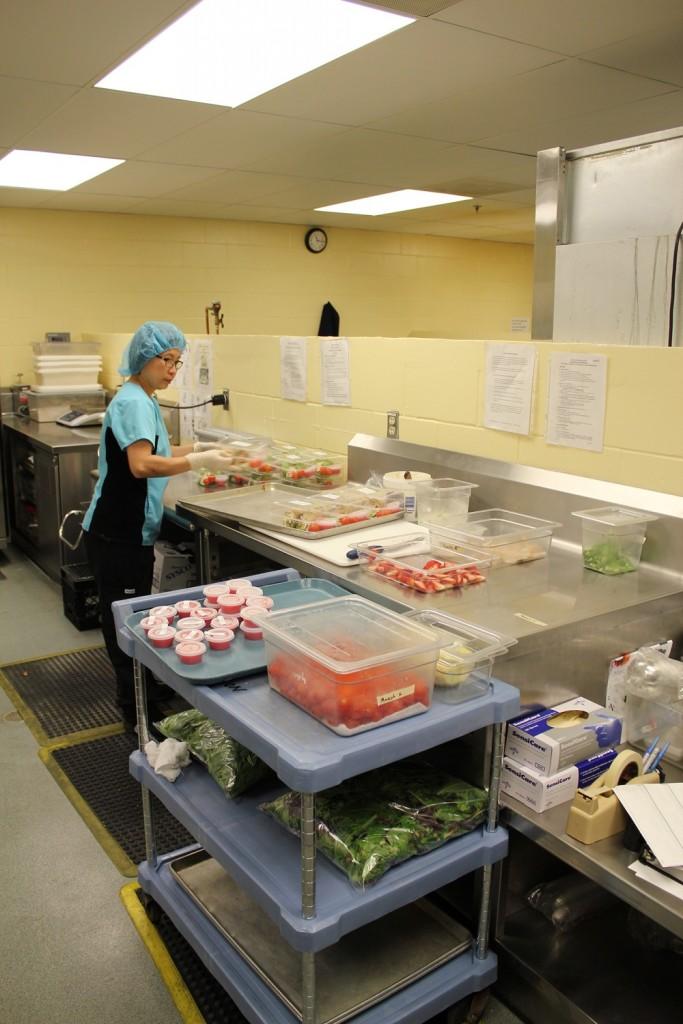Hospital Cafeteria Food: Healthier Than You Think
by Sara Chow

Thunder Bay Regional Health Sciences Centre’s (TBRHSC) Flavours Cafeteria prepares more meals from scratch than most think. Flavours is just one more example of how cafeterias are changing their reputation from ‘mystery meat’ to healthy, mindful options.
When you hear the words ‘cafeteria food’, the first thought that pops into your mind probably isn’t ‘healthy’. It’s more likely that you’re associating cafeteria with imagery of giant ladles serving blended foods and mystery meat onto a tray. However, in recent years, cafeterias have become a major focus for healthy eating initiatives, including Thunder Bay Regional Health Sciences Centre’s (TBRHSC) Flavours Cafeteria.
Nutrition and Food Services’ footprint at TBRHSC covers approximately 11,000 sq. ft., including their receiving area, kitchens, coolers, and Flavours. It’s a large and complex operation that is highly planned in order to be safe, high quality, and healthy. Planning isn’t just about food preparation though, it’s also about implementing healthy principles into daily practice as well, including:
Made Fresh
Way more food than you think is made fresh from scratch, including: lasagnas, soups, wraps, salads, sandwiches, sauces etc. “I bet we do more home-cooked meals than what most people do in their homes,” says Cafeteria and Catering Supervisor, Cathy Sawicki. Part of their focus on making fresh meals from scratch is from the implementation of Sodexo’s ‘Mindful’ retail program that introduced a new fresh and health-focused menu.
In terms of being made fresh, the biggest surprise for many is probably that meats (i.e. turkey, chicken and beef roasts) are cooked from raw in large ovens, cut, then chilled and organized for same or next day patient and Flavours meals. Most would probably assume that the chicken found in a salad was shipped to TBRHSC in a package of some sort, but this is not the case. Flavours makes fresh meals.
Made Local
If you toured through the seven large coolers, you would see many fresh vegetables and fruits that Nutrition and Food Services use to make their meals healthier. However, what’s even better is that some of these vegetables are from local farmers. “We try to support our local farms and purchase local food as often as we can. There are some restrictions because of the quality and safety standards that we must follow, but Sodexo Purchasing has worked with local vendors to ensure that some local products can be used,” explains Sawicki.
Currently, the Nutrition and Food Services is committed to buying local carrots, onions and potatoes, with plans for more local foods in the near future. They also buy free-range eggs, and during Fresh Market (TBRHSC’s farmers’ market) season, they often pair up with the farmers to produce local meals that are available for purchase at Flavours over the lunch hour. In the past they have made pizza, soups and salads using local ingredients.
Made to Order
When it comes to feeding so many people and trying to keep them satisfied and healthy, Nutrition and Food Services do what they can to improve patient satisfaction. ‘Expressly for You’ is a Sodexo Healthcare Program whereby TBRHSC Nutrition and Food Services staff use an iPad at bedside with patients to record their preferences. This information is then shared with the diet office who enter the data into their menu program.
At Flavours, there are ‘stirfry’ days on Tuesdays and Wednesdays, and Fridays are ‘deli days’. On these days, staff, patients and visitors can order their stirfry or deli sandwich just the way they like it, using a variety of vegetables, sauces, deli meats, cheeses, breads, and sides. Although Flavours cannot make everyone exactly what they would like all the time, they are always willing to listen to customers helpful feedback with the comment/suggestion box. In the last week of March they will be accepting feedback from staff on what snacks they would like to see available in Flavours at booths hosted by TBRHSC’s Eat Well! Committee.
Made by Many
Nutrition and Food Services runs like a well-oiled machine. It takes a large, organized, and dedicated team to produce the number of meals required each day for patients, staff, visitors and volunteers. From receiving a fresh tomato to its storage, preparation, and sale or distribution, care is taken to produce the highest quality meals that can be provided in the quantity required.
When it comes to healthy eating options, cafeterias are definitely in the mix, even at TBRHSC. While they need to focus on producing mass quantities of food, they are also focused on the health value and quality of their meals.